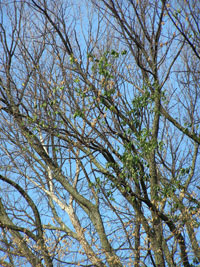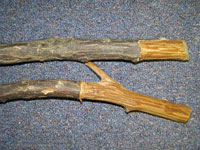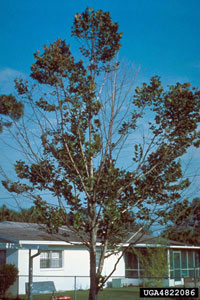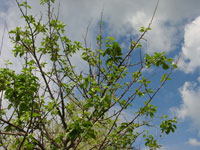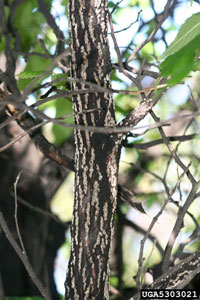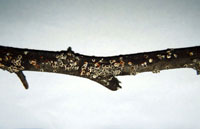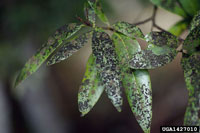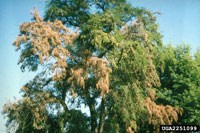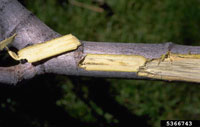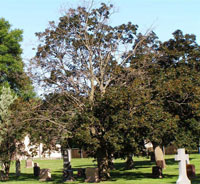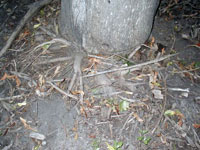Extension > Garden > Diagnose a problem > What's wrong with my plant? > Deciduous Trees > Elm > Leaves on a portion of the branches turn yellow
Elm > Leaves > Leaves on a portion of the branches turn yellow
1 of 6
Dutch elm disease
Ophiostoma ulmi and Ophiostoma novo-ulmi
- Initial infection occurs on one branch; disease may quickly progress to all branches
- Leaves turn yellow, wilt or shrivel, turn brown, then fall off the branch
- Peel back bark on symptomatic branch to reveal brown streaking on wood
- Healthy elms neighboring infected elms soon show symptoms due to spread through root grafts
- Wood pecker holes with bark loss is common on trees killed by Dutch Elm Disease
- American, red or slippery and rock elm are highly susceptible
- More information on Dutch elm disease
2 of 6
Botryodiplodia canker
Botryodiplodia ulmicola
- Leaves growing beyond the canker turn yellow and wilt (Siberian elm) or fall off (American elm)
- Clumps of adventitious sprouts or shoots develop below cankers on large branches
- Reddish brown to black water soaked cankers form on branches 4 inches in diameter or smaller
- Sap wood underneath the canker is reddish brown
- Tiny raised pimple like fungal structures form on branches killed by the canker, causing bark to look rough
- Damage is most severe on trees stressed by other factors
- More information on canker
3 of 6
Oystershell scale
Lepidosaphes ulmi
- Feeding can cause foliage to yellow
- Twig and branch dieback can occur when branches are heavily infested
- Light to dark brown, elongated, 1/10 to 1/8 inch long, found feeding on branches
- Heavy infestations can completely cover bark
- Damage occurs during summer
- More information on Oystershell Scale
4 of 6
European elm scale
Gossyparia spuria
- Yellow leaves on lower branches
- Heavy infestations cause premature leaf drop and dieback of branches
- Excrete honeydew so leaves and branches may be covered by sooty mold
- Dark gray oval body outlined by white wax
- Found mainly on American and rock elm
- More information on European elm scale
5 of 6
Verticillium wilt
Verticillium dahliae
- Leaves are small and yellowed in chronic infections
- Leaves turn brown from the edges and tips, wilt and die in severe infections
- Leaf symptoms are often seen on only one branch in the canopy
- Dark brown to black streaks often can be seen in the sapwood if the bark is peeled back, appearing as rings or arcs in a cross cut
- Symptoms may develop over a single growing season, or over several years
- More information on Verticillium wilt
6 of 6
Stem girdling roots
- Affected trees are often stunted, exhibit poor summer color, change color and lose their leaves early in the fall
- Affected trees commonly exhibit excessive and abnormal winter damage including frost cracks and dieback
- A root circling the trunk of the tree may be seen at the soil line
- Trunk may become sunken in or compressed where it contacts the root
- If girdling root is below ground, the trunk will lack the natural widening or flare at the soil line so will go straight into the earth like a telephone pole; trees often exhibit an abnormal lean
- Affected trees commonly exhibit water-stress symptoms such as marginal leaf scorch, wilting, sudden leaf fall
- More information on Stem girdling roots




